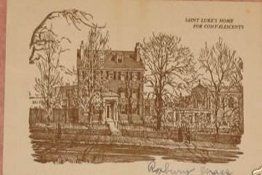Our History
A Tradition of Caring
Sherrill House is a 196-bed not-for-profit nursing and rehabilitation center with roots in the city of Boston dating back to the 19th century.
It all began at 80 Windsor Street in Roxbury, where the Windsor Home, a not-for-profit home for aged women was established. By 1896, the name was changed to the Rachel L. Allen Home, in honor of the woman who served as parish visitor for Trinity Church in the City of Boston. In 1907, the Rev. Doctor Alexander Mann, Trinity’s Rector, along with concerned parishioners from Trinity Church, built a new structure in Jamaica Plain, named Trinity Church Home for the Aged. When this three-story home for 25 women opened in 1910, it was hailed as one of the first of its kind in the community, and set a standard in care for the elderly for decades to come. A similar venture, St. Luke’s Home for Convalescents, located in Roxbury, had been serving the community since 1870. St. Luke’s and Trinity provided superior care for their residents, and ran on parallel paths for nearly 100 years.
During the 1950s, the Commonwealth of Massachusetts began to exercise rigorous public safety regulations affecting homes for the elderly. The Trinity structure was eventually deemed obsolete in the face of these new regulations. In 1966 the home was closed, and the building was torn down in 1968. During this same period, the St. Luke’s Home faced similar difficulties and was forced to shut its doors in 1967. A committee under the guidance of the Rt. Rev. Frederic C. Lawrence, Suffragan Bishop of the Diocese of Massachusetts, was established to locate a new facility. The committee elected to join the Board of Trustees of both St. Luke’s and Trinity Church with the Episcopal Diocese of Massachusetts to establish a new extended care facility. The new home would carry forth the mission of both the Trinity Church Home and St. Luke’s Home, to care for the elderly. This unique triumvirate built a 164-bed, five story brick building on the site of the former Trinity Church Home for the Aged. Dr. Theodore Parker Ferris, Trinity’s rector, asked Bishop Henry Knox Sherrill to lend his name to this home that would provide the best possible care to all people, without regard to race or religion. In July of 1970, Sherrill House was officially opened.
In 1995, the operation of The Frank Wood Home for Convalescents and Incurables, a not-for-profit facility formerly located in Dorchester, joined forces with Sherrill House. The Frank Wood Home’s resources added significantly to the financial strength of Sherrill House, and served to strengthen Sherrill House’s role as a leader in elder care in the Boston area.
Recognizing that an attractive, state-of-the-art physical plant would be necessary to ensure that we could successfully meet residents’ needs in the years ahead, the Sherrill House Board of Directors decided to add a new wing and fully renovate the existing facility. In 2003, they broke ground on the biggest building project in the organization’s history.
In 2004, in response to community needs, a new, short-term transitional care unit was established to provide rehabilitation services to individuals who required care following a hospitalization. Concurrently, a program designed to prepare patients to return to their homes as quickly as possible, the Return to Home™ program, was developed and located on the transitional care unit. Since its inception, the short-term program has been highly successful, and is viewed as an important resource for both the medical community and for patients and families in the surrounding neighborhoods.
The entire Sherrill House community had reason to celebrate in 2007. After five years, work on the organization’s renovation and expansion project was finally completed. The new building, with its numerous amenities and technological enhancements, has been designed to improve residents’ quality of life and to make the working environment more pleasant and efficient for staff. As a result of the expansion project, capacity has been increased from 164 to 196 beds, making Sherrill House one of the largest nursing facilities in Boston. In 2007, Sherrill House observed its centennial anniversary, a culmination of one hundred years of elder care at the organization’s Jamaica Plain location.
In June 2010, after two years of planning and fundraising, a lovely new therapeutic garden, The Thompson Family Serenity Garden, opened at Sherrill House. The garden provides a safe and secure outdoor space where our residents and their families can visit, stroll, and take in the sounds and sights of the natural world. The garden can also be viewed from the sunlit William V. Tripp III Garden Sitting Room, which offers an inviting space for visits and reflection throughout the year.
Sherrill House represents a century-old tradition of attending to the needs of the most vulnerable among us. Today, we remain committed, as our founders were, to providing the very best care possible to our patients, residents, and families, and we are confident that our rich heritage, ecumenical spirit, and dedication to community, will serve as strong building blocks for the future.




